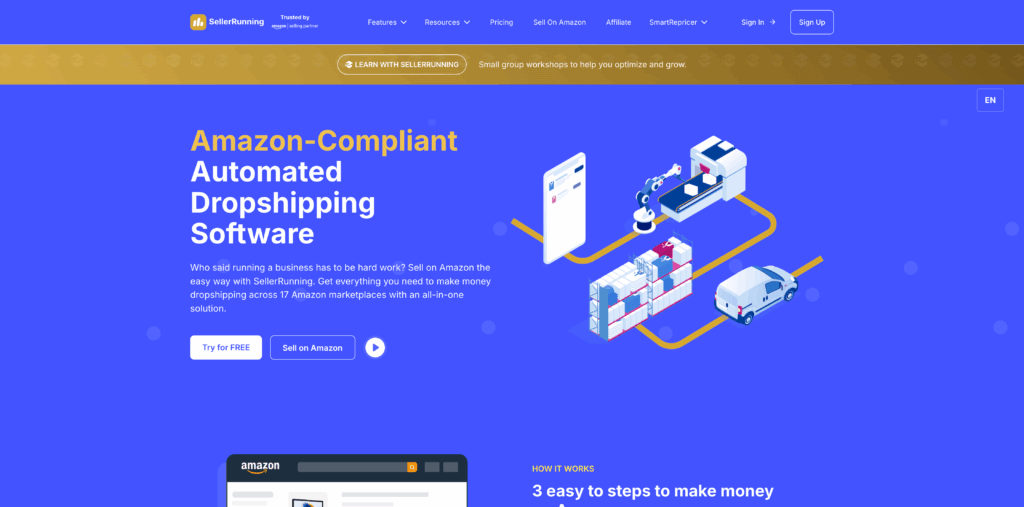- Blog
-
For Sellers
A handy guide to finding the best dropshipping tools
Choosing the right dropshipping tools can make or break your store.

Here’s the thing about dropshipping: it looks deceptively simple on paper. Find products, list them on your store, collect orders, and let someone else handle the shipping. Easy, right? Until you realize you’re juggling supplier communications, inventory updates, customer service tickets, and order tracking—all while trying to find products that actually sell.
The good news is you don’t have to manage everything manually. Smart dropshipping tools can automate the tedious stuff, help you find winning products, and connect you with reliable suppliers. The challenge is picking the right ones for your specific needs without breaking the bank or overcomplicating your setup.
This guide walks you through everything you need to know about dropshipping tools—from understanding what they actually do to choosing the ones that’ll genuinely help your business grow.
What is a dropshipping tool and why do you need one?
Why dropshipping tools?
Well, why not?
Most are designed to be user-friendly and easy to set up. They’re also accessible and allow you to start selling your products online.
Dropshipping tools are software or services designed to help dropshippers streamline operations, enhance efficiency, and provide better customer experiences. Depending on the tool you choose, you can:
- Automate manual tasks
- Reduce errors
- Conduct product or market research
- Find suppliers, manufacturers, or wholesalers
- Build your own storefront
With that said, there are several types of tools available, and each one is designed to address specific aspects of dropshipping.
Product research
Dropshipping product research tools help you find the right products to sell. They conduct comprehensive market analysis, identify customer preferences, and analyze product performance. By leveraging data, these tools can identify winning products that meet the following criteria:
- Meet your customers’ needs
- Have high demand
- Good profit potential
A good product research tool goes beyond product scouting. It also allows you to explore different markets, which helps you find new product ideas. There are also product research tools that let you perform competitor analysis. These research tools will give you a glimpse of what the competition is offering, along with other helpful details like the number of ratings or reviews they have.
Supplier sourcing
Finding reliable suppliers is one of the biggest challenges in dropshipping. Supplier sourcing tools can help you find and connect with global suppliers who can provide you with high-quality products. These tools often have a database of suppliers or manufacturers across different industries.
Product management
Product management tools cover several aspects of the dropshipping process, from order fulfillment to tracking. For example, some of these tools can help you manage your suppliers and send tracking updates to customers automatically.
Customer service
Customer service tools are designed to help you deliver enhanced customer support and communication through features like:
- Helpdesk management
- Ticketing systems
- Live chat
Automation
These tools let you automate different dropshipping-related tasks like creating product listings. Depending on the tool you select, some are capable of automating aspects like order processing and price monitoring. Some tools can also automate bulk product imports and order tracking.
Key features to consider in a dropshipping tool
No two dropshipping tools are alike. Each one provides a different set of features, from automation to product or competitor research. With that said, here are the key features you need to consider before choosing a dropshipping tool:
1. Product sourcing and inventory management
A good dropshipping tool should be capable of finding and importing products from reliable suppliers. It should also integrate with popular ecommerce platforms and must-have inventory management features like stock updates (so you can sync the supplier’s stock information on your site) and automatic ordering. Inventory management capabilities give you real-time updates on inventory levels.
Some tools are also capable of setting competitive product prices. This ensures that your prices appeal to customers while letting you make a profit.
2. Order fulfillment automation
If you’re handling multiple orders, things can quickly get chaotic. Order fulfillment automation is capable of automatically:
- Placing orders with suppliers
- Generating tracking numbers
These capabilities help simplify the order process and let you keep your customers in the loop, which translates to better shopping experiences for them.
3. Customer relationship management
This is a must-have feature if you want to provide exceptional customer service. This allows you to provide order tracking and communication tools for shoppers. Also, consider whether your dropshipping tool can integrate with your preferred customer support platform.
4. Analytics and reporting
In dropshipping, like most other business models, data is crucial. It helps you assess your performance and learn more about your customers. These, in turn, give you valuable insights you can use to make data-driven decisions, identify patterns, and optimize your strategy to drive growth and profitability.
In addition to these features, your dropshipping tool should allow you to customize your product listings. Adding your branding or value-added product descriptions helps your business stand out from the competition. Also, see if a dropshipping tool is capable of integrating suppliers. This feature allows you to access the supplier’s product range, which then lets you expand your product catalog.
Picking the right dropshipping tool for your business needs
Choosing the best dropshipping tool for your business is crucial to streamlining your operations and scaling your business. To make an informed decision, you need to carefully evaluate the following points:
Your business needs
As with any endeavor, it’s always best to start by identifying your business needs. For instance, what type of products do you want to sell, or how many orders are you looking to accommodate? Asking these questions will help you find a dropshipping tool that supports your requirements.
Aside from these questions, it’s also a good practice to identify potential bottlenecks. What issues are keeping your dropshipping business from growing? Furthermore, account for your goals (short- and long-term). Do you want to boost your conversion rate or expand your product catalog? Think about how a particular dropshipping tool will help you achieve specific goals.
Lastly, think about your current business stage. For example, if you’re just starting out, consider going for a dropshipping tool that’s beginner-friendly with basic features. If you’re looking to grow your business, opt for tools with more advanced automation and integration features.
Your preferred ecommerce platform
Choose a tool that’s compatible with the ecommerce platform you’re using. Also, consider if a tool can seamlessly integrate with your current tech stack.
Product features
Look for a dropshipping tool that has the key features mentioned earlier. Doing so will help you find a tool that:
- Offers a comprehensive product and supplier range
- Saves you time (automation)
- Provides you with robust analytics for performance tracking and making data-driven decisions
On top of these considerations, your dropshipping tool should have integrated marketing capabilities. These help you attract new customers and promote your business. If the dropshipping tool doesn’t offer all of the features you need, chances are you’re going to spend a lot more on add-ons or other solutions.
User experience
The best tool is one that you love using because, well, it’s easy to use. See if a tool has an intuitive and user-friendly interface. A good tool makes it easier for you to run your business—it shouldn’t be another hurdle to your growth. In addition to these features, see if the vendor provides a comprehensive onboarding process. This helps speed up your adoption of the tool.
Supplier reliability
Your dropshipping tool must be capable of connecting you with reliable suppliers. This gives you a guarantee that you and your customers will have access to high-quality products and hassle-free delivery.
Pricing
Think about your budget. You want to get the best tool, but buying an expensive tool won’t always guarantee the best results. Make sure that you compare several providers and tools. Check their pricing plans to see if they have a solution that fits your budget. Lastly, check to make sure that there are no hidden fees for extra features or premium support.
Scalability
A great dropshipping tool is scalable. It should be capable of supporting your business as it grows. See if a dropshipping tool offers advanced features like upgrades or higher-tier plans, which may come in handy if you’re thinking about expanding your business in the future.
Level of customer support
Using a dropshipping tool won’t always be smooth sailing. Some may come with a slight learning curve, or you may encounter issues every once in a while. When choosing which tool to use, make sure that the vendor can provide you with easily accessible customer service. Also, see if they provide helpful resources like training, tutorials, or guides.
Supercharge your dropshipping business with SellerRunning

If traditional dropshipping feels like managing too many moving pieces, a tool like SellerRunning offers a more streamlined approach specifically for Amazon sellers. Instead of juggling multiple suppliers and tools, you can quickly add thousands of products from Amazon US search results directly to your inventory, then identify which items are worth dropshipping to other Amazon marketplaces globally.
The real advantage is SellerRunning’s automated warehouse system (SR House), which handles international fulfillment from start to finish. The system repackages dropshipped products to remove original seller branding and ensures you appear as the seller of record—keeping you compliant with Amazon’s requirements without the usual operational headaches. All of this happens automatically at no additional cost.
Another thing that sets SellerRunning apart is its focus on automation where it matters most. Orders are automatically matched between your seller and buyer accounts, shipments are confirmed instantly, and the system even protects your account by pre-confirming orders that risk being marked late. The browser extension eliminates file downloads and uploads entirely—just search for items on Amazon and let your preset rules filter and price everything automatically.
SellerRunning handles the operational complexity so you can focus on what actually grows your business: finding profitable products and serving customers well. Sometimes the best dropshipping tool is the one that eliminates the need for most others.
The tools are just the beginning
Look, dropshipping tools can solve a lot of problems, but they can’t solve the fundamental challenge of building a business people actually want to buy from. You still need great products, solid supplier relationships, and customer service that doesn’t make people want to leave angry reviews.
Your tools should make the operational stuff easier so you can focus on what really matters: finding products people love, building a brand they trust, and creating experiences that keep them coming back.
Start small, test what works for your specific situation, and scale up from there. The right combination of tools can turn dropshipping from a constant juggling act into a business that actually runs smoothly.
Want to go beyond dropshipping or start somewhere easier?
If pure dropshipping feels too complicated, consider starting with Amazon FBA instead and explore Seller 365—our complete toolkit for online selling that includes everything from product sourcing to inventory management in one subscription.






















